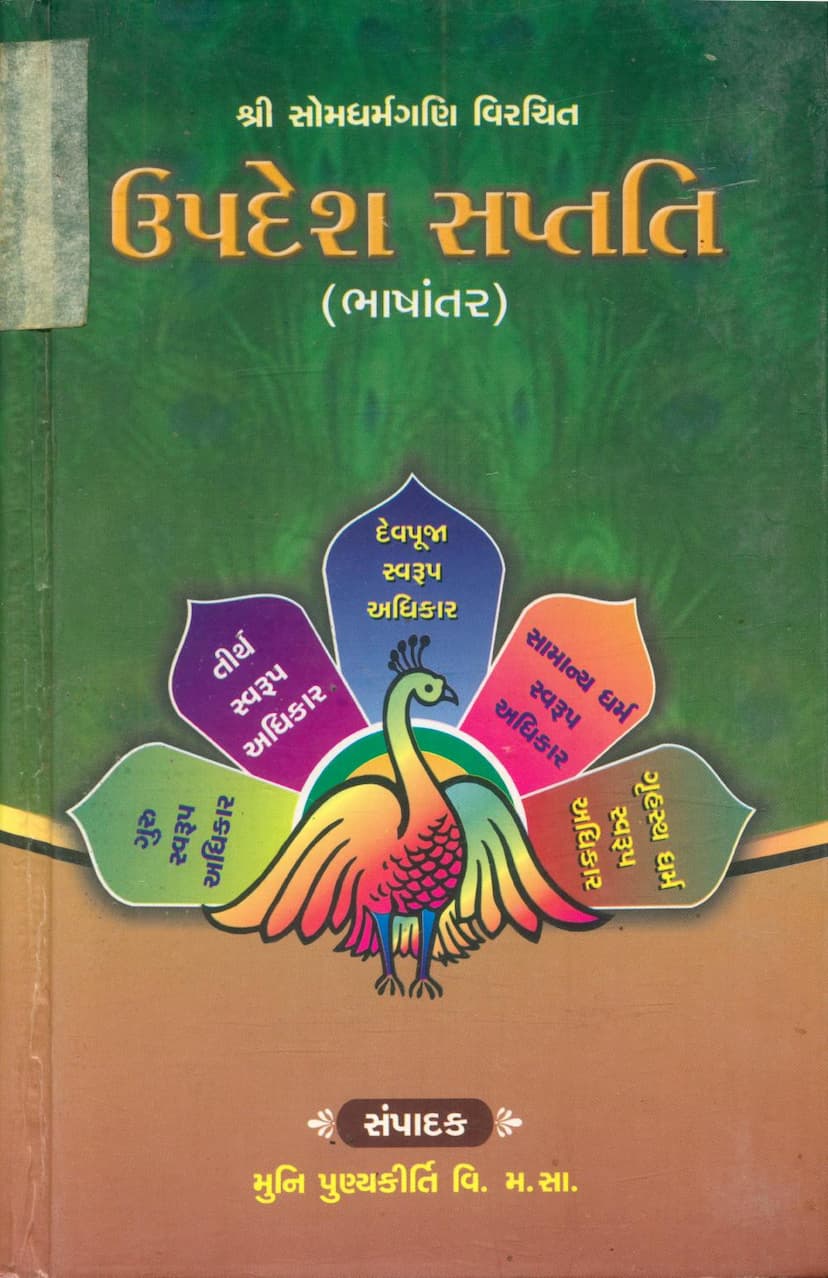Updesh Saptati
Added to library: September 2, 2025

Summary
Here's a comprehensive summary of the Jain text "Updesh Saptati" by Punyakirtivijay, based on the provided content:
Updesh Saptati: A Compendium of Jain Wisdom
"Updesh Saptati," authored by Punyakirtivijay and published by Sanmarg Prakashan, is a significant Jain text that aims to guide individuals towards spiritual well-being and liberation through various teachings and narratives. The book is a translation and compilation of the original work by Shri Somdharma Gani.
Core Structure and Content:
The text is structured into five main sections, each focusing on a crucial aspect of Jain philosophy and practice:
-
Deva Puja Adhikar (Worship of the Divine): This section comprises 24 teachings that elaborate on the nature of the divine (Arhats) and the significance of their worship. It describes the divine attributes, the auspicious signs (atishayas) of the Tirthankaras, and the various forms of worship, emphasizing the importance of sincere devotion over mere rituals. Stories illustrate the profound benefits of worshipping the divine, even with simple offerings or intentions.
-
Tirth Adhikar (Holy Places of Pilgrimage): This section, with 17 teachings, highlights the spiritual importance of sacred pilgrimage sites in Jainism. It details the sanctity and significance of prominent Tirthas like Girnar, Bhruoch, Arbuda-giri, Shatrunjaya, and others, often recounting the stories of venerated figures associated with them. The teachings underscore the merit gained by visiting and respecting these holy places.
-
Guru Tattva Adhikar (The Nature of the Spiritual Guide): This section, consisting of 5 teachings, focuses on the essential role of the Guru in the spiritual journey. It praises the virtues of a Guru, emphasizes the importance of Guru-vandan (salutation to the Guru), and recounts the lives of exemplary spiritual leaders, showcasing their wisdom and dedication.
-
Samanya Dharma Adhikar (General Principles of Righteousness): This extensive section contains 12 teachings that cover a wide range of ethical and moral principles fundamental to Jainism. It delves into virtues like forgiveness, patience, truthfulness, non-violence, and the consequences of vices like anger, pride, greed, and attachment. Through illustrative stories, it guides readers on cultivating virtuous qualities and avoiding pitfalls that hinder spiritual progress.
-
Grihasth Dharma Adhikar (The Duties of a Householder): This section, with 17 teachings, specifically addresses the conduct and responsibilities of householders. It emphasizes the importance of righteous living, charity, compassion, adherence to vows, and maintaining a balanced approach to worldly life while prioritizing spiritual growth. The narratives often highlight the rewards of fulfilling one's duties with devotion and integrity.
Key Themes and Messages:
Across all sections, "Updesh Saptati" consistently emphasizes several core Jain principles:
- The Importance of Samyak Darshan (Right Faith): The text highlights that true faith in the Tattva Trayi (the three truths: divine beings, spiritual guides, and righteous conduct) is the foundation of spiritual progress.
- Sincere Devotion: It stresses that the intent and sincerity behind actions, particularly in worship and virtuous conduct, are more crucial than the outward display or the cost of the offerings.
- The Role of Karma: Many stories illustrate the law of karma, showing how actions, both positive and negative, have consequences that shape one's present and future lives.
- The Significance of Ethical Conduct: The text consistently promotes virtues like compassion, forgiveness, truthfulness, and non-violence, showcasing their transformative power.
- The Guidance of the Guru: The teachings underscore the indispensable role of a qualified spiritual guide in navigating the complexities of spiritual life.
- The Value of Pilgrimage: Visiting holy sites is presented as a means of accumulating merit and strengthening spiritual resolve.
- Living a Righteous Life: The book provides practical guidance for householders on how to live virtuously, fulfill their worldly duties, and progress spiritually.
Narrative Style:
The teachings in "Updesh Saptati" are primarily conveyed through captivating stories and parables, making the profound philosophical concepts accessible and relatable to a broad audience. These narratives often feature historical figures, divine beings, and ordinary individuals whose lives serve as examples of the principles being taught.
Overall Purpose:
"Updesh Saptati" serves as a comprehensive guide for spiritual aspirants, offering practical advice, ethical guidance, and inspirational narratives rooted in Jain tradition. By understanding and applying these teachings, readers are encouraged to purify their souls, cultivate virtues, and ultimately strive for liberation (Moksha).